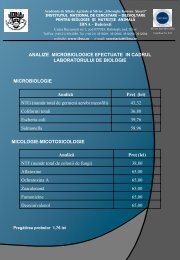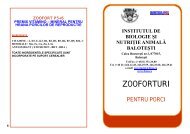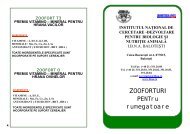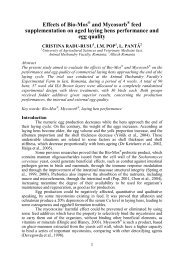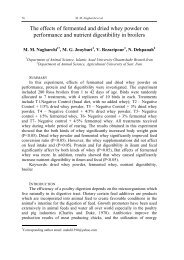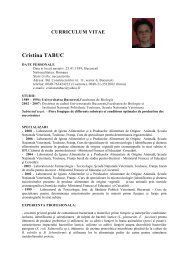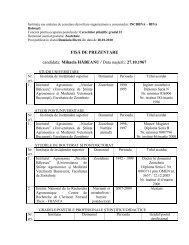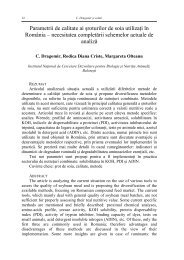Protein requirement of Japanese quail (Coturnix coturnix ... - IBNA
Protein requirement of Japanese quail (Coturnix coturnix ... - IBNA
Protein requirement of Japanese quail (Coturnix coturnix ... - IBNA
You also want an ePaper? Increase the reach of your titles
YUMPU automatically turns print PDFs into web optimized ePapers that Google loves.
Archiva Zootechnica 14:3, 37-42, 2011 37<br />
Effects <strong>of</strong> different sources <strong>of</strong> boron<br />
supplementation to diet on egg shell quality<br />
and bone characteristics in laying hens<br />
Y. Cufadar, O. Olgun, Y. Bahtiyarca<br />
Selçuk University, Faculty <strong>of</strong> Agriculture, Department <strong>of</strong> Zootechny, 42075, Konya,<br />
Turkey<br />
SUMMARY<br />
This study was conducted to determine the effect <strong>of</strong> different<br />
sources <strong>of</strong> boron supplementation to diet on egg shell quality and bone<br />
biomechanical characteristics in layer hens. At 44-wk-old 60 laying hens<br />
(Super Nick White) were fed to five dietary treatments during the 44-72<br />
wk periods. Each treatment consisted <strong>of</strong> six replications <strong>of</strong> 12 hens (two<br />
hens per cage). Five treatments diets consisting <strong>of</strong> control and plus<br />
containing 300 mg/kg boron as boric acids, anhydrous borax, borax<br />
pentahydrate and borax decahydrate, respectively. During the<br />
experiment, feed and water were used as ad-libitum. The different<br />
sources <strong>of</strong> boron supplementation did not significantly effect on egg shell<br />
quality parameters (P> 0.05), except for egg shell thickness during the<br />
60-64 weeks and egg shell strength during the 68-72 week in laying<br />
hens (P< 0.01, P
38<br />
Y. Cufadar et al.<br />
(1984) suggested that the trace mineral supplements to chemically<br />
defined diets should contain at least 2 ppm B. several studies have<br />
indicated that B is an important mineral normal bone formation, egg<br />
production, eggshell quality parameters in laying hens. Wilson and<br />
Ruszler (1995) investigated the effects <strong>of</strong> supplemental dietary B on egg<br />
production and bone strength <strong>of</strong> laying hens. No significant differences<br />
were observed in the bone shear force, shear stress or the shear<br />
fracture energy at any <strong>of</strong> the B concentrations (3.5, 7, 14, 28 or 56<br />
mg/kg B). Qin and Klandorf (1991) indicated that B did not affect shell<br />
quality but increase tibia bone ash. Eren et al. (2004) investigated that<br />
dietary B supplementation (0, 10, 50, 100, 200 and 400 mg/kg B) effect<br />
on egg production, interior and exterior egg quality in laying hens. The<br />
egg quality parameters were affected by the dietary B levels. Yeşilbağ<br />
and Eren (2008) reported that supplementation dietary B laying hens<br />
better eggshell quality. Olgun et al. (2009) reported that B<br />
supplementation had no effect on eggshell thickness and eggshell<br />
breaking strength in molted laying hens. Mızrak and Ceylan (2009)<br />
indicated that dietary supplemental B had no effect on tibia and femur<br />
breaking strength in laying hens.<br />
The purpose <strong>of</strong> this study was to determine the effects different<br />
sources <strong>of</strong> B supplementation to diet on eggshell quality and tibia<br />
breaking strength characteristics in laying hens.<br />
MATERIAL AND METHODS<br />
At 44 weeks old 60 laying hens (Super Nick White) were fed to five<br />
dietary treatments during the 44-72 weeks periods. Each treatment<br />
consisted <strong>of</strong> six replications <strong>of</strong> 12 hens (two hens per cage). Five<br />
treatments diets consisting <strong>of</strong> control and plus containing 300 mg/kg<br />
boron as boric acids, anhydrous borax, borax pentahydrate and borax<br />
decahydrate, respectively. During the experiment, feed and water were<br />
used as ad-libitum.<br />
The eggs were subjected to determine characteristics <strong>of</strong> egg shell<br />
quality parameters (shell thickness and shell breaking strength) on all<br />
collected eggs produced at the last two days <strong>of</strong> each period during the<br />
experiment. Egg shell breaking strength was measured using a<br />
cantilever system by applying increased pressure to the broad pole <strong>of</strong><br />
the shell using an instrument (Egg Force Reader, Orka Food<br />
Technology, Israel). Eggshell thickness was average eggshell measured<br />
at 3 locations on the egg (air cell and two location in the equator) using a<br />
micrometer (Mitutoyo, 0.01 mm, Japan).<br />
Bone mechanical properties were determined from the loaddeformation<br />
curve generated from a three point bending test (ASAE<br />
Standard S459, 2001) using an Instron Universal Testing Instrument
Archiva Zootechnica 14:3, 37-42, 2011 39<br />
(Model 1122; Instron, Canton, MA) and the TestWorks 4 s<strong>of</strong>tware<br />
package (version 4.02; MTS System Corporation, Eden Prairie, MN).<br />
These mechanical properties <strong>of</strong> bone are described by Wilson and<br />
Ruszler (1996) and Armstrong et al. (2002).<br />
Table 1. Composition <strong>of</strong> experimental diet<br />
Ingredients %<br />
Corn 46.0<br />
Barley 7.4<br />
Soybean meal ( 47.6 % Crude 22.7<br />
<strong>Protein</strong>)<br />
Sunflower meal (30 % Crude 8.1<br />
<strong>Protein</strong>)<br />
Vegetable oil 4.5<br />
Limestone 8.8<br />
Dicalcium phosphate 1.75<br />
Salt 0.40<br />
Premix 1 0.25<br />
Methionine 0.10<br />
TOTAL 100.00<br />
Calculated nutrients<br />
ME, kcal kg -1 2802<br />
Crude <strong>Protein</strong>, % 18.05<br />
Calcium, % 3.85<br />
Available phosphorus, % 0.45<br />
Lysine, % 0.892<br />
Methionine, % 0.374<br />
Methionine + Cystine, % 0.714<br />
1 Premix provided/kg <strong>of</strong> diet; Mn: 60 mg; Fe: 30 mg; Zn: 50 mg; Cu: 5 mg; 1, 1.1 mg; Se: 0.1 mg,<br />
Vitamin A, 8.800 IU; Vitamin D 3, 2.200 IU; Vitamin E, 11 mg; Nicotinic acid, 44 mg; Cal-D-Pan, 8.8<br />
mg; Rib<strong>of</strong>lavin 4.4 mg; Tiamin 2.5 mg; Vitamin B 12, 6.6 mg; Folic acid, 1 mg; D-Biotin, 0.11 mg;<br />
Choline: 220 mg<br />
Data were subjected to ANOVA by using General Linear Model<br />
procedure (GLM) in Minitab (2000). Duncan’s multiple range tests were<br />
applied to separate means (Duncan, 1955). Statements <strong>of</strong> statistical<br />
significance are based on a probability <strong>of</strong> P
40<br />
Y. Cufadar et al.<br />
weeks <strong>of</strong> period. Eggshell breaking strength was not affected by<br />
supplementation <strong>of</strong> different B sources except for 68-72 weeks <strong>of</strong> period.<br />
According to the results <strong>of</strong> studies in previous years, Qin and<br />
Klandorf (1991), Wilson and Ruszler (1996) and Eren et al. (2004)<br />
reported similar results. Eggshell breaking strength in older hens (68-72<br />
weeks <strong>of</strong> age) was positively affected by B supplementation. This result<br />
is <strong>of</strong> great importance, because decline <strong>of</strong> shell quality with increasing<br />
age <strong>of</strong> layers is serious problem in egg industry. Similarly, Yeşilbağ and<br />
Eren (2008) stated that eggshell breaking strength increased by B<br />
supplementation in aged laying hens.<br />
All sources <strong>of</strong> B used in the diet <strong>of</strong> laying hens caused a positive<br />
effect on bone stress and bone strength. Wilson and Ruszler (1998)<br />
reported that a similar results <strong>of</strong> laying hens when from 50 to 200 mg/kg<br />
B (as boric acid) was added to their diet. Bone stress and bone strength<br />
were positive affected by the 200 mg/kg B. In another study, Wilson and<br />
Ruszler (1997) reported that there was a significant increase in the<br />
shear force and shear stress <strong>of</strong> the tibia for leghorn pullets<br />
supplemented with 50 and 100 mg/kg <strong>of</strong> dietary B.<br />
Table 2. Effects <strong>of</strong> supplemental dietary B (300 mg/kg) from different sources<br />
eggshell quality and bone parameters<br />
Diets<br />
Control Boric Anhydro Borax Borax<br />
Weeks<br />
SEM<br />
acid us borax pentahy decahy<br />
Eggshell<br />
thickness<br />
, mm<br />
Eggshell<br />
breaking<br />
strength,<br />
kg<br />
drate drate<br />
44-48 0.351 0.364 0.367 0.357 0.341 0.0072<br />
48-52 0.322 0.322 0.322 0.314 0.317 0.0057<br />
52-56 0.329 0.343 0.351 0.339 0.334 0.0069<br />
56-60 0.349 0.351 0.348 0.343 0.336 0.0051<br />
60-64 0.289 b 0.301 ab 0.324 a 0.302 ab 0.309 ab 0.0075<br />
64-68 0.330 0.309 0.318 0.307 0.302 0.0076<br />
68-72 0.323 0.323 0.332 0.325 0.312 0.0068<br />
44-72 0.328 0.330 0.337 0.327 0.322 0.0044<br />
44-48 2.93 2.90 3.08 3.14 2.73 0.229<br />
48-52 2.64 2.77 2.81 2.83 2.70 0.170<br />
52-56 2.38 2.18 2.65 2.84 2.52 0.303<br />
56-60 2.35 2.36 2.52 2.42 2.40 0.154<br />
60-64 2.32 2.61 2.22 2.18 2.17 0.224<br />
64-68 2.13 2.15 2.41 2.44 2.14 0.201<br />
68-72 1.56 B 1.78 AB 2.18 A 2.06 AB 2.22 A 0.129<br />
44-72 2.33 2.39 2.55 2.56 2.41 0.117<br />
Shear force, N 596.6 647.2 702.3 694.2 649.7 43.44<br />
Shear strength, 43.15 b 52.22 a 51.29 a 51.54 a 48.38 ab 1.86<br />
N/mm 2<br />
Fracture energy,<br />
N.mm<br />
465.7 b 659.6 a 719.4 a 650.3 a 707.4 a 59.85
Archiva Zootechnica 14:3, 37-42, 2011 41<br />
A, B: Values in columns are statistically different; P
42<br />
Y. Cufadar et al.<br />
Wilson, J.H. and Ruszler, P.L., 1996. Effects <strong>of</strong> dietary boron<br />
supplementation on laying hens. British Poult. Sci. 37, 723–729.<br />
Wilson, J.H. and Ruszler, P.L., 1997. Effects <strong>of</strong> boron on growing pullets.<br />
Biol. Trace Elem. Res., 56 (3):287-94.<br />
Wilson, J. H. and Ruszler, P.L., 1998. Long term effects <strong>of</strong> boron on<br />
layer bone strength and production parameters. British Poult. Sci. 39,<br />
11-15.<br />
Yeşilbağ, D. and Eren, M., 2008. Effects <strong>of</strong> dietary boric acid<br />
supplementation on performance, eggshell quality and some serum<br />
parameters in aged laying hens. Turk. J. Vet. Anim. Sci., 32(2): 113-<br />
117.


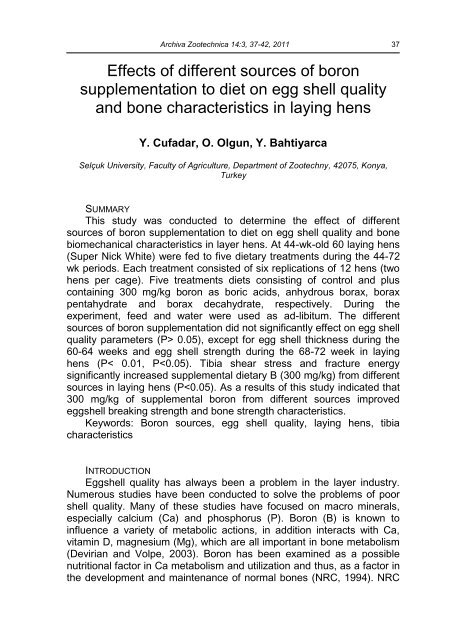
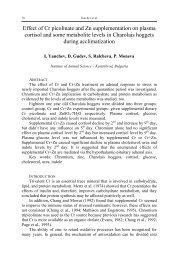
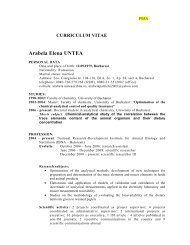
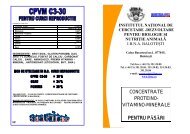
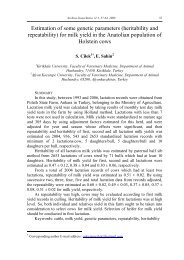
![( ) ( ) [ ] ( ) ( ) ( ) ( ) [ ]n ( ) ( ) [ ]n](https://img.yumpu.com/22443310/1/184x260/-n-n.jpg?quality=85)
